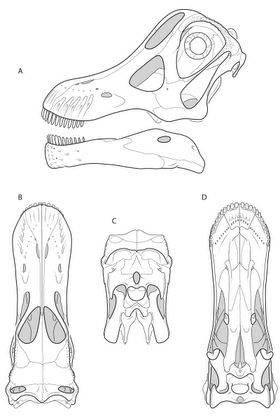ANN ARBOR, Mich. With their long necks and tails, sauropod dinosaurs famous as the Sinclair gasoline logo and Fred Flintstone's gravel pit tractor are easy to recognize, in part because they all seem to look alike.
The largest animals known to have walked the earth, sauropods were common in North America during the middle of the dinosaur era but were thought to have been pushed to extinction by more specialized plant-eaters at the end of that era. New discoveries, however, are showing that one lineage of sauropods diversified at the end of the dinosaur era, University of Michigan paleontologist Jeffrey Wilson says.

Reconstruction of the skull and lower jaw of Nemegtosaurus mongoliensis in left lateral (A), dorsal (B), posterior (C) and ventral (D) views. Illustration by Bonnie Miljour
Wilson's recent restudy and reconstruction of the skull of a Mongolian sauropod adds to a growing body of evidence for sauropod diversity at the end of the dinosaur era. Wilson described the reconstruction and the conclusions he drew from it in a paper published Aug. 24 in the Journal of Systematic Palaeontology.
He based the reconstruction on two nearly complete skulls that were found in the Gobi Desert in the 1950s and 1960s but whose evolutionary relationships have remained enigmatic. In the 1990s and early 2000s, Wilson restudied the skulls and found characteristics identifying them as skulls of titanosaurs, a late surviving sauropod lineage.
"Titanosaurs, which were surprisingly common at the end of the dinosaur era, were really the only sauropod lineage that flourished. All the others went extinct," said Wilson, an assistant professor of geological sciences and an assistant curator at the University of Michigan Museum of Paleontology. But as prevalent as titanosaurs were, they left behind surprisingly few skulls. Paleontologists have found plenty of other titanosaur bones, providing a picture of a group of sauropods with specialized limb bones.
Wilson began to appreciate the finer points of titanosaurs as a graduate student, when he and another student studied fossilized sauropod tracks and titanosaur limb anatomy. From those studies, Wilson concluded that unlike other sauropods, titanosaurs walked with their feet planted far from the middles of their bodies, an unusual style of "wide gauge" locomotion.
"Most animals walk with a narrow gauge, with their feet close to the midline, because it's energetically more efficient to walk that way. But some sauropod trackways tell us that a group of sauropods were walking with a new wide-gauge stance. We can identify characteristics of titanosaurs that would have allowed that stance, and we can tie the appearance of those features with the proliferation of wide gauge tracks everywhere in the fossil record at the end of the dinosaur era." Wilson wonders if the change in locomotion from typical sauropod narrow-gauge walking to titanosaur wide-gauge walking —corresponded to lifestyle changes, such as different feeding habits. But without skulls to study, it has been hard to draw conclusions about how and what titanosaurs ate.
With his work and that of researchers at the State University of New York, Stony Brook who announced the discovery of a complete titanosaur skeleton in 2001, sauropod specialists finally can start piecing together a clearer picture of the dinosaurs' lives.
One feature of the skulls is particularly intriguing. "They have elongate, sort of horse-like skulls with many openings and grooves on the outer surface of their snouts," said Wilson, who worked closely with U-M Museum of Paleontology artist Bonnie Miljour over the course of a year preparing the paper's many illustrations of the skull reconstruction. "Blood vessels and nerves passed through these holes and may suggest an especially sensitive snout. This probably had some role in feeding, but we haven't investigated it at all."
Oddly, a group of distantly related sauropods evolved a similarly grooved snout. "Apparently, these two different branches of sauropods gravitated toward similar anatomical structures, perhaps because they were specialized for eating certain types of vegetation."
Learn more about Jeff HERE and HERE.